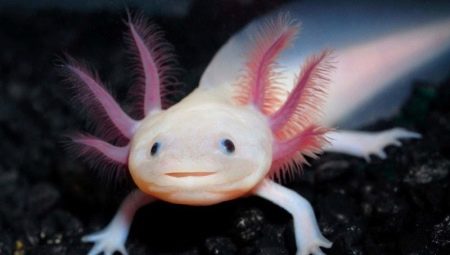Axolotli is one of the most amazing and unusual representatives of the aquarium fauna. Their appearance causes a wide variety of emotions in people - from indescribable delight to slight disgust. However, the appearance of axolotls is not able to leave a single person indifferent. What is this creature? What size can it achieve when kept in an aquarium? What are the features of its content and breeding at home?
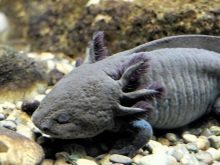
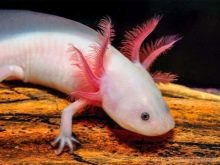
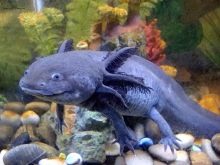
Who is that?
Axolotl is the larva of an ambistoma, a representative of the amphibian genus found in North America. An amazing feature of this creature is that it is able to achieve puberty without going through the phase of transformation into an adult. This is facilitated by the specific features of the work of his thyroid gland, which usually does not produce the thyroidin hormone in the amount necessary to turn axolotl into an ambo.
For this feature, axolotls are classified as neotenics (literally translated from the ancient Greek language, “neoteny” means “extended youth”) - creatures that can remain in a larval state for life. Such a phenomenon is often found among tailed amphibians - newts, ambistos, salamanders.
Most often, the term “axolotl” is used in relation to the larvae of a terrestrial amphibian, called the “Mexican ambistoma”. However, this term applies to all neotenic larvae of absolutely any ambisto.
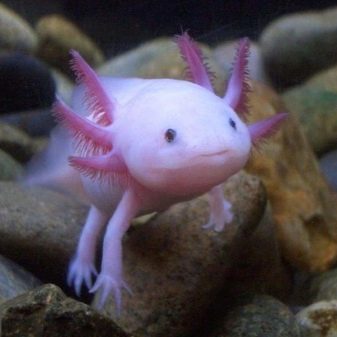
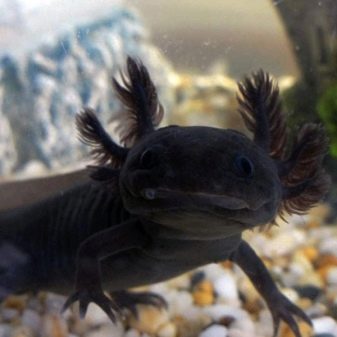
Other popular names for axolotls are “water salamander”, “aquarium dragon”, “water monster”, “water dragon”. Indeed, these cute creatures look very much like fairy dragons. It is noteworthy that their funny and touching appearance at one time inspired the famous animator Darina Schmidt to create a funny cartoon character named Luntik.
Visually, these creatures resemble small newts with a large head and an elongated, slightly flattened body. On the lateral sides of the head are external gills, which look like long fluffy branches.
The head of the axolotl visually appears disproportionately large, slightly flattened. Looking at the creature’s wide extended mouth, it seems that the axolotl is constantly smiling. The amphibian mouth is littered with tiny, but rather sharp teeth, with which the animal holds and chews food. Despite the fact that Ascolotl is a predator, he is unable to break his prey.

External gills (3 on each side) resemble pubescent twigs directed from the head toward the body. It is noteworthy that during the period of transformation of the axolotl into an adult (amphibian), its gills disappear within a few weeks.
Eyes - small, dark (sometimes with a light iris), visually similar to beads or small buttons. In some albino axolotles, the eyes have a red tint.
The body is elongated, streamlined. On the back along the body of these creatures is a long ridge that provides the axolotl with maneuverability when moving in water. The entire body of the larva is covered with delicate and thin skin. In some albino axolotles, it seems translucent.
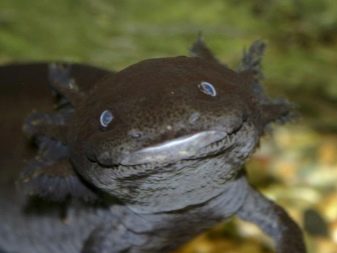
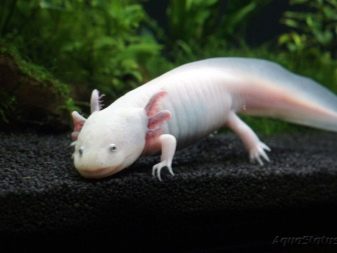
There are 4 fingers on the front legs of the aquarium dragon, and 5 on the hind legs. The axolotl looks very touching, trying to clean the external gills of the front gills from adhering dirt. At this moment, it resembles a small alien or a toy revived.
The maneuverability in water of these creatures provides not only the dorsal crest, but also a rather long tail, which makes up about a third of the entire length of the body. Females have smaller body sizes compared to males. The tail of the axolotl girls is also inferior in length.
The color of the creatures depends on a number of factors, such as:
- conditions of detention;
- nutrition features;
- features of the population.
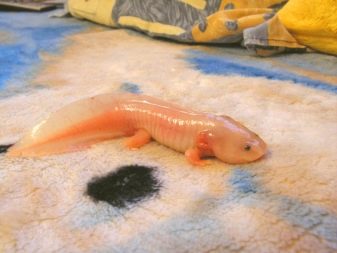
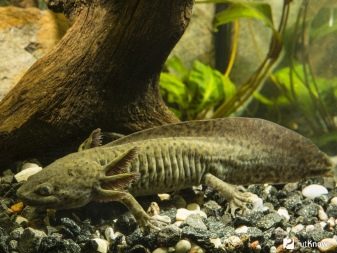
In most cases, home-made axolotls are black, brown-brown, dark gray, swamp green, pinkish-white, or pinkish-beige. Axolotli albinos are completely white, without any marks, patterns or spots on the body. At the same time, their branchial processes have a deep red color.
Interesting results were achieved by scientists involved in the crossbreeding of representatives of various populations. So, to date, a fantastically beautiful variety of axolotls has been developed, in which the patterns and marks on the skin emit a slight glow under a fluorescent lamp.
Most axolotls prefer to lead a calm and measured lifestyle. They spend most of the time at the bottom, slowly moving along pebbles and snags. By their nature, these creatures are sedentary and inert phlegmatic. They are not characterized by hyperactivity, fussiness, injustice. Occasionally, they can swim to the surface of the water and freeze in one position, methodically fingering.
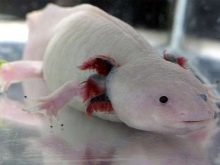
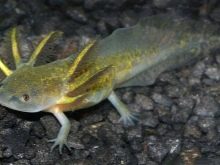
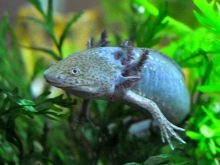
Dimensions
The average axolotl sizes vary from 15 to 30 centimeters. Rarely found males reaching 45 centimeters in length.
These creatures with proper care and comfortable conditions of detention are able to grow quite quickly. So, from a 5-centimeter baby in just six months, a fairly large individual 20–22 centimeters long can grow.
According to experts, in the first couple of years of life, these creatures can reach a length of 30 centimeters or more.
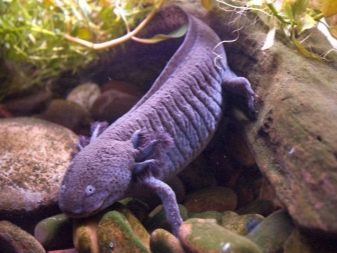
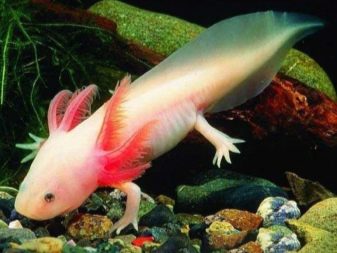
How many lives?
In the natural habitat, the lifespan of these amazing creatures rarely exceeds the threshold of 10 years. This is due to the vulnerability of axolotls to aggressive environmental factors, fluctuations in water temperature, predators and other sources of danger.
When kept at home, these creatures are able to live from 15 to 20 years or more.
However, to achieve such results is very difficult due to the increased claim of axolotls to the conditions of detention.
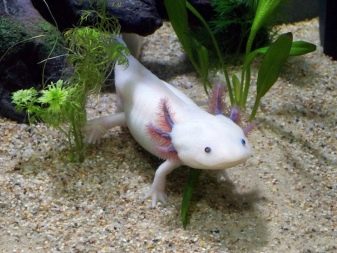
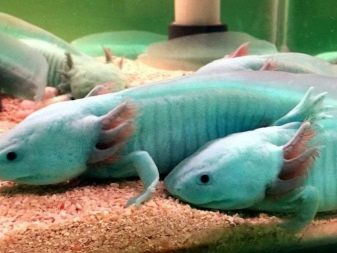
Color options
As already mentioned, the color palette of axolotls is extremely diverse. In accordance with the peculiarities of the coloring of axolotls, it is customary to distinguish three main types:
- Albinos, Albi, or Albino - these include all creatures of an even snow-white color with red outer gills and light red eyes;
- White or light - these include all individuals that are not "albums", but having a light pink or pale cream color and eyes with a dark iris;
- "Naturalists" - these include all individuals with a dark color - the most common among axolotls in their natural habitat.
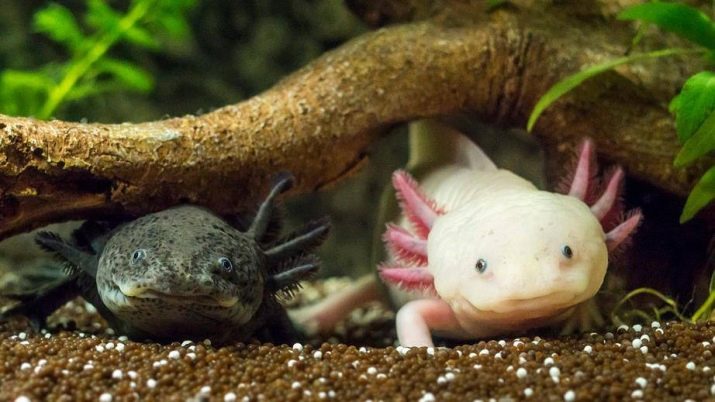
The larvae with a golden hue look very impressive and original. These creatures are artificially bred. They attract attention with their rich juicy lemon color, which distinguishes them against the background of aquarium decorations. The external gills of golden individuals are usually colored in coral or pinkish-orange.
Axolotls of dark swamp, dark brown and almost black color are also very impressive. A vivid example here is the black Mexican axolotl, which has a deep anthracite color. Visually, these creatures resemble large lizards or monitor lizards.
When purchasing individuals of this color, you should worry about the decor of a contrasting color, because against the background of snags and stones the dark axolotl will simply “get lost”.

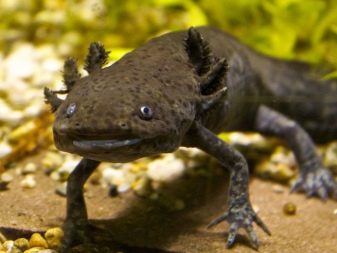
Purple or violet axolotl (often referred to as “purple”) is another spectacular, but rather rare representative of the aquarium fauna that makes an indelible impression. The color of these creatures can range from pale lavender to lilac-purple. The external gills of such creatures usually have a pinkish-purple hue.
It should be noted that the color of axolotls is one of the factors affecting their price. The rarer the color of the animal is considered, the higher its value will be.
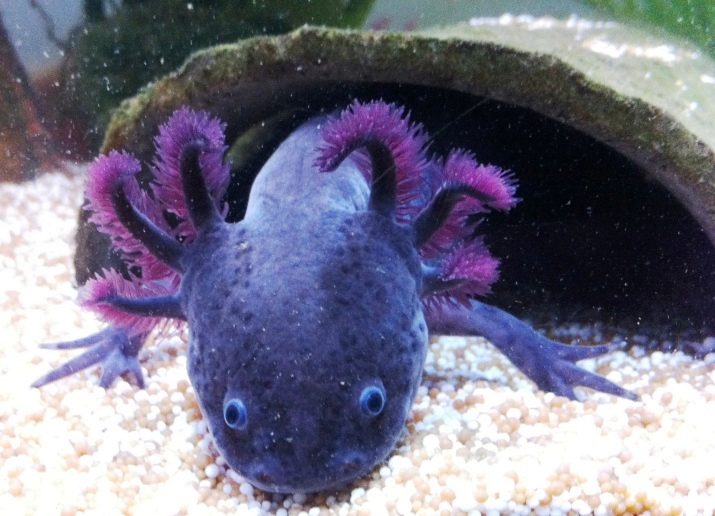
Content Features
No matter how strong the desire to get axolotl as a pet, experienced aquarists recommend not rushing to make a decision. The fact is that these gentle and quick-witted creatures are very pretentious to the conditions of existence and care. Any deviation from the rules of their maintenance can cause health problems and even painful death.
In the global network, there are often sources that claim that these creatures do not have special requirements for their content. This is completely contrary to reality, misleading beginner aquarists.
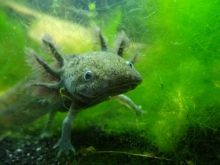

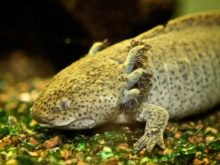
In order for axolotls to feel comfortable, they need specific conditions of detention. This implies:
- the presence of an aquarium of a suitable volume;
- high-quality soil;
- the presence of shelters;
- purity and comfortable temperature of water;
- varied diet and balanced daily menu.
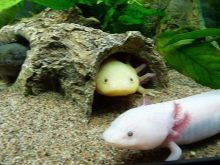
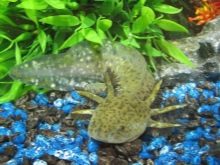
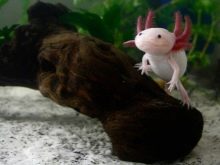
Aquarium
Despite the fact that axolotls are not hyperactive creatures that prefer to frolic in the water column, they need a sufficient amount of free space. So, for the maintenance of one individual, an aquarium with a capacity of at least 35-40 liters is required.
To keep a pair of axolotls, a tank of 90-100 liters is suitableequipped with powerful water filtration and aeration systems.These cute creatures will feel good in an aquarium in which a filter with an absorbing sorbent is installed, providing a small circulation of water.
It is highly recommended to give preference to models of equipment with the most quiet operation, since loud sounds are very scary axolotl.
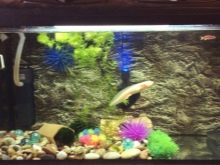

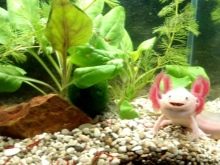
Priming
Ground coating must be present in the aquarium with axolotl. Preferring to spend a significant part of the time in days at a depth, these creatures are measuredly moving along the bottom, clinging with their paws to stones and obstacles protruding from the ground.
but when choosing a suitable soil, it should be borne in mind that for the maintenance of these underwater inhabitants it is necessary to select only large-fraction mixtures. Small pebbles and gravel axolotli can easily be swallowed and even choke on them. The optimal bottom filler in this case will be coarse gravel and coarse pebbles.
It is important that the stones have round or blunt edges that axolotls cannot hurt.
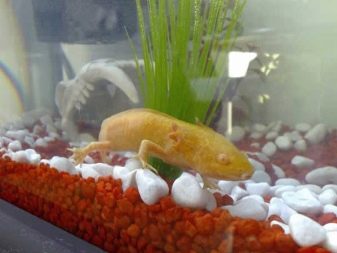
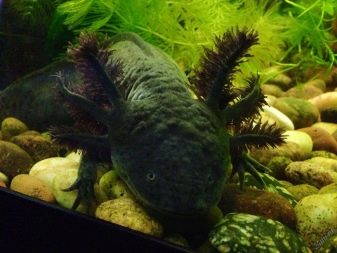
Shelters
Axolotls are quite curious, but at the same time cautious creatures. From any sources of danger, they prefer to hide in shelters. If there are none nearby, the aquarium dragon will experience constant stress.
For shelters, it is recommended to use processed driftwood, ceramic products, bizarre-shaped stones, pots, decorative arches, caves and grottoes. These items will help not only to create full-fledged shelters for axolotls, but also to give the tank an original style.
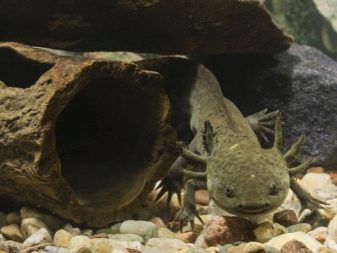
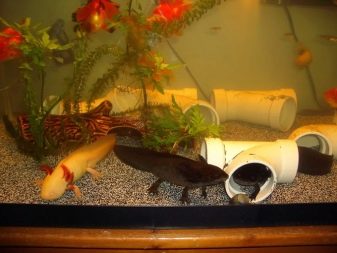
Equipping the aquarium with decorating elements, we must not forget that axolotls are owners of very delicate and sensitive skin. They can easily injure themselves against sharp corners, protruding edges of decor items.
Given this fact, it is worthwhile to select objects of exclusively rounded (therefore, safe) shape for arranging an aquarium interior.
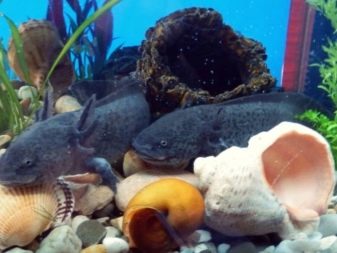
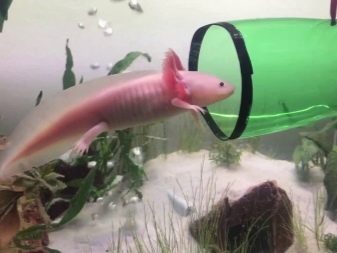
Cleanliness and water temperature
Water purity is an important, but not vital indicator for the comfortable existence of axolotls. They are able to easily tolerate the slight turbidity of the water, the presence of algal plaque on the surfaces of the walls of the aquarium, plant leaves and decor. However, such a situation should not be allowed, and therefore it is advisable to regularly conduct surface cleaning of the aquarium, add fresh water to the tank weekly and remove the remaining uneaten feed from it.

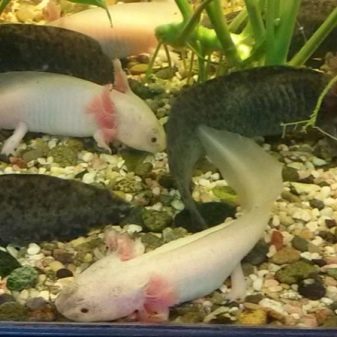
The most important and vital indicator in the content of axolotls is the temperature of the water. In the wild, these extraordinary creatures live in cold-water areas. High water temperature is deadly for them. Its increase above the 23 ° mark can cause a severe deterioration in the well-being of pets, and subsequently their painful death. So, when the thermometer reaches a critical point of 26 °, axolotls will inevitably die.
For this reason the aquarium with axolotls must be equipped with a working and accurate thermometer. The most comfortable conditions for these creatures arise at a stable temperature of 13-15 °, less comfortable - at a temperature of 15-20 °. Thus, the warmer the water in the aquarium, the worse its inhabitants will feel.
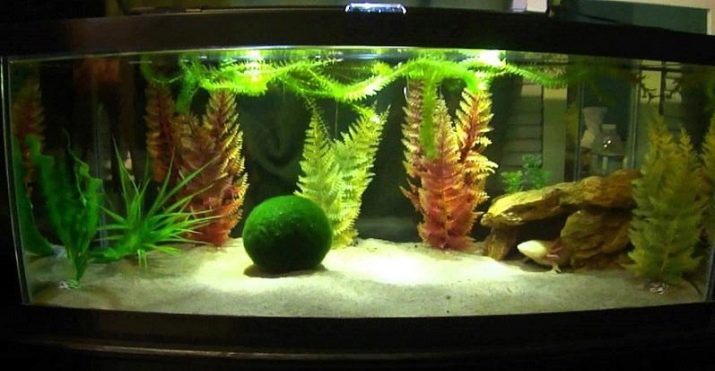
Very often, novice aquarists are faced with a problematic situation, suggesting a steady increase in temperature in the aquarium in the hot summer. There are several ways to reduce and stabilize the temperature to normal in this situation. The simplest, but short-lived method involves placing ice tanks in the aquarium.
Many aquarists containing axolotls, in attempts to reduce the temperature of the water in the aquarium, implement rather original solutions. One of them is the installation of compact USB fans above the aquarium, directing the flow of air to the surface of the water.
This method of lowering the temperature is considered quite troublesome and costly. However, despite the fact that it requires ingenuity, its effectiveness is undeniable.
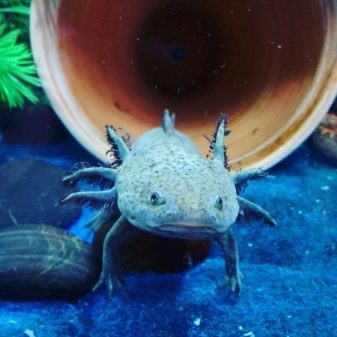

Diet and daily menus
The health, well-being and life expectancy of axolotls largely depend on how competently and correctly composed their diet. These cute amphibians can not be fed uniform food, accustoming to only one type of product.
Preferably, the main component of the axolotl menu is live fresh food - bloodworms, small earthworms. They willingly absorb slices of fresh fish fillet, slices of shrimp, squid, mussels and other mollusks. However, feeding the axolotl of such food is fraught with some difficulties, since these moving predators are attracted only by moving objects. In this case, it is recommended to feed the pet with tweezers, cutting the food into thin strips. Some axolotl breeders manage to feed treats with their hands.

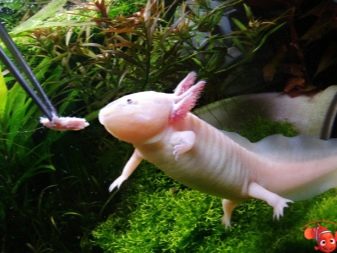
It is important to note that live feed intended for axolotls must be of high quality. There are frequent cases when infected or spoiled food (in particular, bloodworms) became the cause of serious infections, poisoning and even death of animals.
The recommended frequency of feeding these creatures is 1 time in 2-3 days. Axolotl babies and individuals under the age of 2 years should be fed every day, but little by little. It should be borne in mind that these creatures prefer to eat up for the future, so it is very important not to overfeed them. After the pet’s meal, the remains of uneaten feed from the aquarium must be removed.
If an aquarium dragon refuses to eat, it almost always indicates that he was sick. These creatures are very vulnerable to infectious and fungal pathogens. During treatment, they are allowed not to feed or give food in very limited quantities.
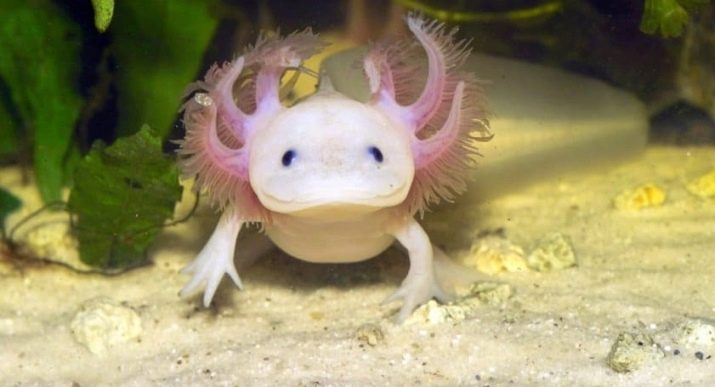
Compatibility
Experts do not recommend containing these creatures with other representatives of the aquarium fauna. Axolotles will eat small fish, and they can suffer from large individuals themselves. Large aquarium fish often injure these creatures by eating their pubescent external gills.
Poor compatibility of axolotls with other inhabitants of domestic reservoirs is largely due to the difference in their requirements for the conditions of detention and water temperature. In cool water, which is comfortable for aquarium dragons, few species of fish are able to live.
The only suitable neighbors for these exotics are goldfish. They have a fairly large size, prefer to live in cool water. In addition, goldfish do not show aggression towards aquarium dragons and get along well with them.
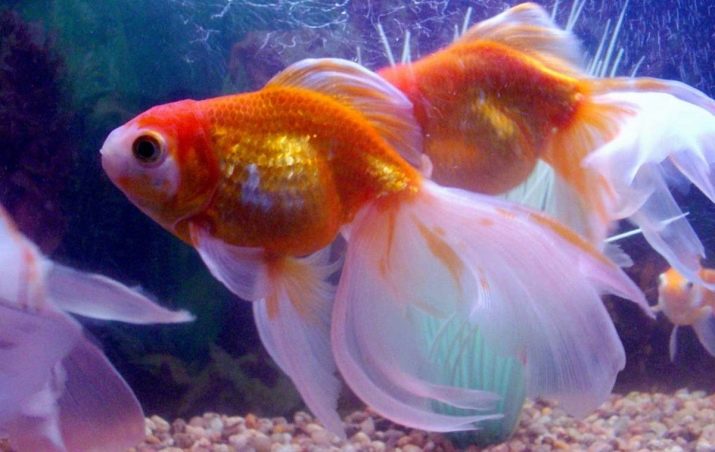
Breeding
These exotic creatures can begin to breed spontaneously - for example, if the temperature of the water in the aquarium drops to 13-14 °, and then again rises to its original level. In other cases, the aquarist is able to stimulate them to reproduce.
To do this, you need to prepare a separate plastic or glass tank with a filter that provides easy circulation of water. It is important that the aquarium is spacious.
To obtain the offspring of axolotls, a couple or one male and 2-3 females should initially be selected.
To distinguish a female from a male, it is necessary to carefully examine the cloacal area of each individual. In females, it is even and smooth, in males it is noticeably convex.
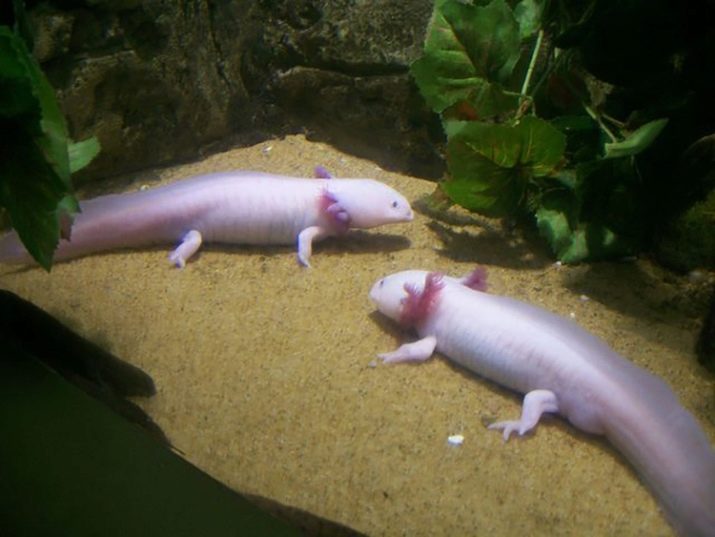
After selection of individuals, they are sedimented into a separate tank and the water temperature is lowered to 13-14 °. After a few days, the temperature is increased to 18 °. Such actions usually stimulate exotic pets to active mating games.
After a short courtship, the axolotl boy will begin to release spermatophores into the water - capsules with a seed. The female will draw them into a cesspool.After about 1-1.5 days (or a little earlier), she will leave eggs. At this point, the male should be removed from the tank.
To lay all the eggs, the female usually needs 1-2 days. During this time, it is necessary to maintain the water temperature at 19 °. After the female finishes laying eggs, she is also removed from the aquarium.

After 15-30 days, tiny larvae of 2-2.5 centimeters in size will begin to appear from the eggs. In the first days of life, they do not have paws. The limbs in babies will develop and form over the next few weeks.
While the baby dragons are growing up, they should be well and properly fed. It is recommended to use ciliates, microworms, cyclops as a starting feed. When the cubs grow up a little, daphnia, small bloodworms, special mixtures for fry are introduced into their diet.
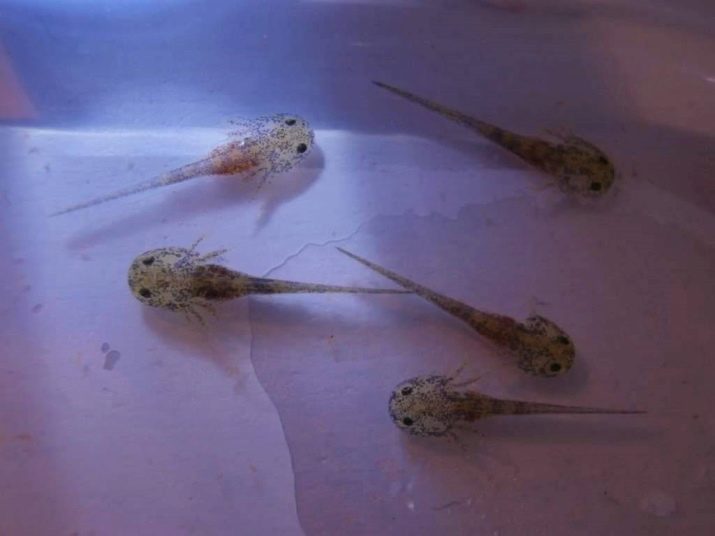
Tips
Experienced aquarists do not recommend picking up these whimsical and sensitive creatures. However, if such a need arose, palms should be pre-cooled - for example, holding hands in very cold water. It is important to remember that the temperature of human skin is much higher than the body temperature of the aquarium dragon. Taking this exot in warm hands, you can cause him a severe skin burn.
When keeping several individuals in an aquarium, it is important to prevent them from starving. Many beginner aquarists are not aware that axolotls are not only predators, but also cannibals. So, in a fit of hunger, they are able to attack each other, bite off the limbs and tail of the neighbors in the tank.
These exotic creatures have pretty poor eyesight. For this reason, do not cover the aquarium too much. The most comfortable water dragons will feel in twilight lighting or light twilight.
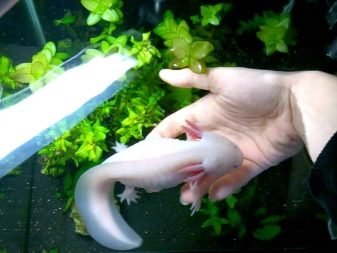
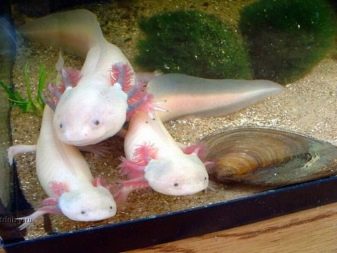
In addition, when maintaining axolotls, it should be remembered that these creatures love silence. Loud sounds scare them, causing severe stress. With the constant influence of stress factors, pets can get sick.
Before you start axolotl, it should be noted that this exot quickly contaminates the water in the aquarium with waste products. It is necessary to clean the excrement behind the pet regularly and as often as possible. In the dirty water, these creatures feel uncomfortable.
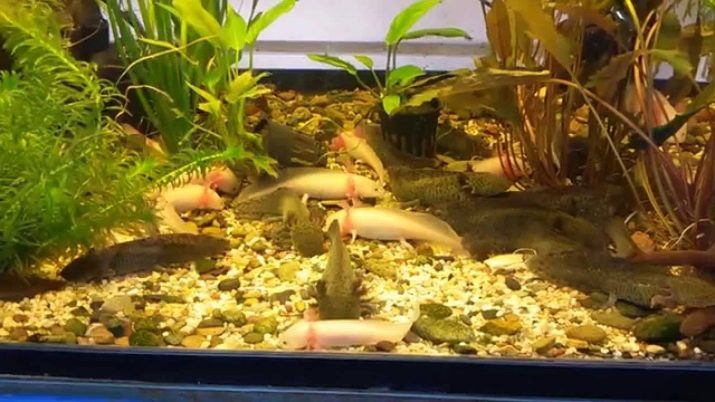
Review Reviews
In the global network you can find a lot of reviews about these cute and funny creatures. Familiarity with this information will be useful for those people who plan to get such an exotic pet.
Axolotl is a very specific pet, which is not suitable for everyone. In the absence of care, they can easily die or become ill. Axolotl treatment is a very expensive and complicated undertaking, since not all clinics can find a veterinarian specializing specifically in amphibians. However, despite the difficulties in maintaining axolotls and providing them with proper care, everything is compensated by the mass of positive emotions that these funny and eternally smiling creatures evoke.
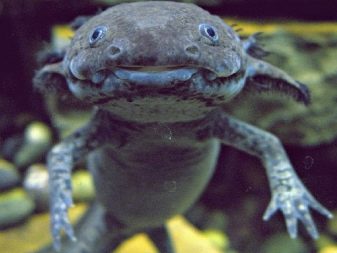
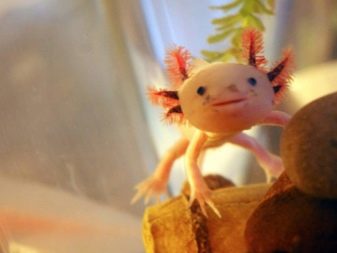
The most difficult part in maintaining axolotl is maintaining the recommended water temperature in summer. In the heat, the water in the aquarium heats up very much, which extremely negatively affects the well-being of the water dragon. You can solve the problem with the help of fans installed above the aquarium, and special thermoses with cold accumulators. Also, in the heat, it is more often necessary to add clean and settled bad-tempered water to the aquarium.
One of the advantages in the content of axolotls is that they actually eat little. Feed them once every few days, which can significantly save on the purchase of feed. They do not need to walk with them, as with dogs, they do not create any noise, do not exude an unpleasant odor, do not fade and live for quite some time. If you provide them with a comfortable existence, then the axolotls will deliver positive emotions to their owners for many years.
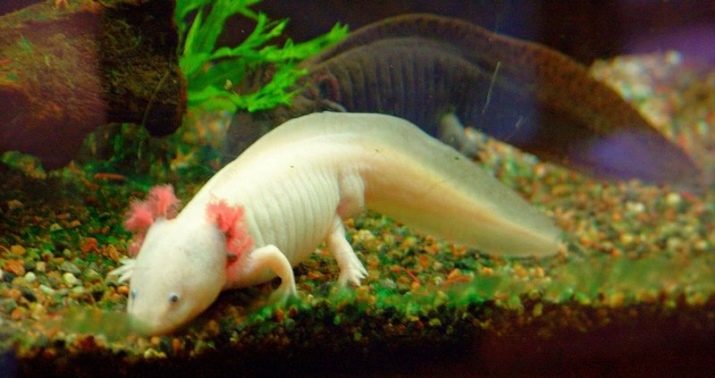
Watching axolotls is a very exciting activity, from which it is hard to break away. The amusing expression of their faces can not help but bring a smile. These creatures, similar to space aliens, evoke especially joyful emotions in children.
If a child lives in the house, then the axolotl will certainly become his favorite and favorite. And although it is hard and difficult to care for these exotics, these concerns are always pleasant.
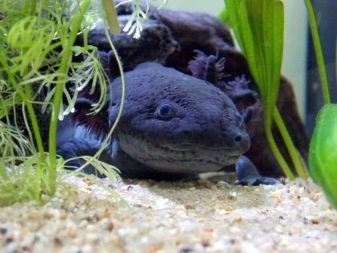
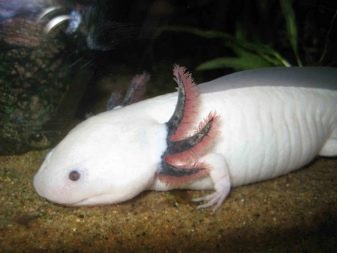
Interesting Facts
Not everyone knows that the body of axolotls has the property of regeneration. So, in place of a torn paw or tail, a new body part will soon begin to form. In addition, not only parts of the body, but also internal organs are regenerated in axolotls.
Another interesting fact is related to the transformation of these creatures into an adult. For this to happen, it is necessary to change the conditions of their detention. In particular, a reduction in the level and temperature of water in the aquarium contributes to this. However, such experiments should not be carried out at home. In most cases, they end with the death of the pet.
It is also noteworthy that the musculoskeletal system of these creatures does not have bones. The skeleton of the axolotl is made up of cartilage, which makes it rather fragile and vulnerable. This is another reason why axolotl is not recommended to be picked up.

Axolotli made a huge contribution to the development of medicine. So, Currently, scientists are studying the characteristics of the body of these animals, investigating the mechanism of their regenerative abilities.. It is possible that these very popular pets in the future will help specialists find effective methods for the quick recovery of the human body, its organs and systems after injuries and complex operations.
In some countries (particularly Japan), axolotls are considered a delicacy. Food lovers claim that the larva of the ambistoma tastes like white diet meat. Oddly enough, but these creatures from ancient times were eaten by representatives of certain tribes. To date, this trend is opposed by zoo protectors seeking to preserve the dying populations of axolotls.
Under the influence of the anthropogenic factor, axolotls were on the verge of extinction. Only a few of their populations survived in their natural habitat. This led to the fact that axolotls were listed in the Red Book as an endangered animal species.
Some aquarists believe that this alarming fact is quite worthy of becoming a convincing argument in favor of buying axolotls for their home keeping and breeding.
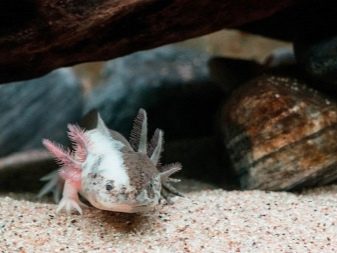

For more information on axolotl features, see the next video.
